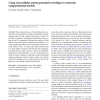Free Online Productivity Tools
i2Speak
i2Symbol
i2OCR
iTex2Img
iWeb2Print
iWeb2Shot
i2Type
iPdf2Split
iPdf2Merge
i2Bopomofo
i2Arabic
i2Style
i2Image
i2PDF
iLatex2Rtf
Sci2ools
JCNS
2007
2007
Using extracellular action potential recordings to constrain compartmental models
Abstract We investigate the use of extracellular action potential (EAP) recordings for biophysically faithful compartmental models. We ask whether constraining a model to fit the EAP is superior to matching the intracellular action potential (IAP). In agreement with previous studies, we find that the IAP method under-constrains the parameters. As a result, significantly different sets of parameters can have virtually identical IAP’s. In contrast, the EAP method results in a much tighter constraint. We find that the distinguishing characteristics of the waveform—but not its amplituderesulting from the distribution of active conductances are fairly invariant to changes of electrode position and detailed cellular morphology. Based on these results, we conclude that EAP recordings are an excellent source of data for the purpose of constraining compartmental models. Keywords Compartmental model · Extracellular recording · Model constraint · CA1 · Pyramidal neuron · Neuron simul...
| Added | 15 Dec 2010 |
| Updated | 15 Dec 2010 |
| Type | Journal |
| Year | 2007 |
| Where | JCNS |
| Authors | Carl Gold, Darrell A. Henze, Christof Koch |
Comments (0)

